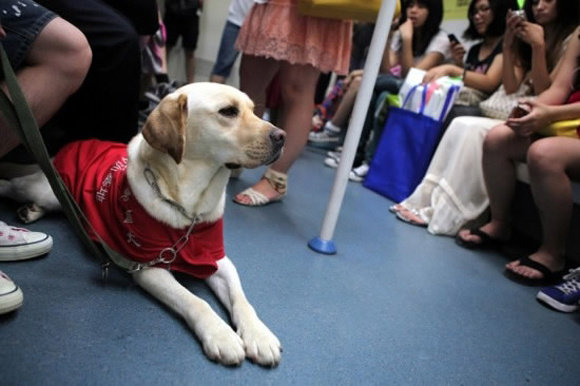
A guide dog on Beijing subway train. (File photo/Xinhua)
Beijing Subway refused a passenger with a guide dog not wearing muzzle to enter the station last Friday though it has a document released in 2015 claiming visually impaired passengers can aboard subway trains with guide dog, Beijing Youth Daily reports.
The female passenger surnamed Xu, together with her guide dog, tried to enter Jintaixizhao Station on Line 10 after she paid for her journey. But the staff at the station said no to her because the dog not wearing a protective device, which usually deemed as a muzzle by subway staff.
From 5 p.m. to 10 p.m., Xu stayed at the station without permission taking the subway, as both sides did not reach an agreement. The passenger left the station with no result at midnight.
Beijing issued a regulation which took effect on May 1, 2015, allowing visually-impaired people to take guide dogs onto the subway if they provide a certificate of visual difficulty and a guide dog license. The regulation also requires the guide dog to wear a harness and a protective device to keep the canine from biting others.
However, both visually impaired people and trainers from the guide dog training base asserted that a muzzle would affect guide dogs’ work.
Zhou said that when she tried to wear the muzzle for her guide dog, “I found my dog stopped work, just wanted to get rid of the muzzle.”
Liang Jia, a trainer from a guide dog training base in Dalian, northeast China’s Liaoning Province, claimed that they will not request the guide dog wearing protective equipment like muzzle while training, as the tool is hard to make dogs keep them cool. Liang added that the base will distribute muzzle after training for security checks in public places, but “long time to wear the muzzle is impossible.”
An unnamed subway staff explained that except basing on the rule released in 2015, they have to pay close attention to passengers' reactions to dogs, especially those who on board with their children, as the subway always has a huge passenger flow.
Guide dog puppies do not wear muzzles during work in many countries in the world, such as the US and Japan, but some are asking to wear head collars to help the dog stay calm and focused when it becomes distracting.
Before the guide dog regulation unveiled in 2015, Chen Yan and her guide dog Jenny had been refused by a Beijing subway station 11 times. Besides, Beijing bus still has no clear rule about guide dog aboard. According to Beijing News last December, 26-year-old Zhou Lei with her guide dog had been rejected to get on bus many times.
China has a huge vacancy of guide dogs, as the country is home to 16.9 million visually-impaired people. Tens of thousands of them apply for a guide dog every year, but the current situation is that only more than a hundred guide dogs are available for those in need.
The number of guide dogs in Beijing? Still far behind its global counterparts, only about two dozen guide dog in Beijing with around 50,000 visually-impaired people living in the city.


















































